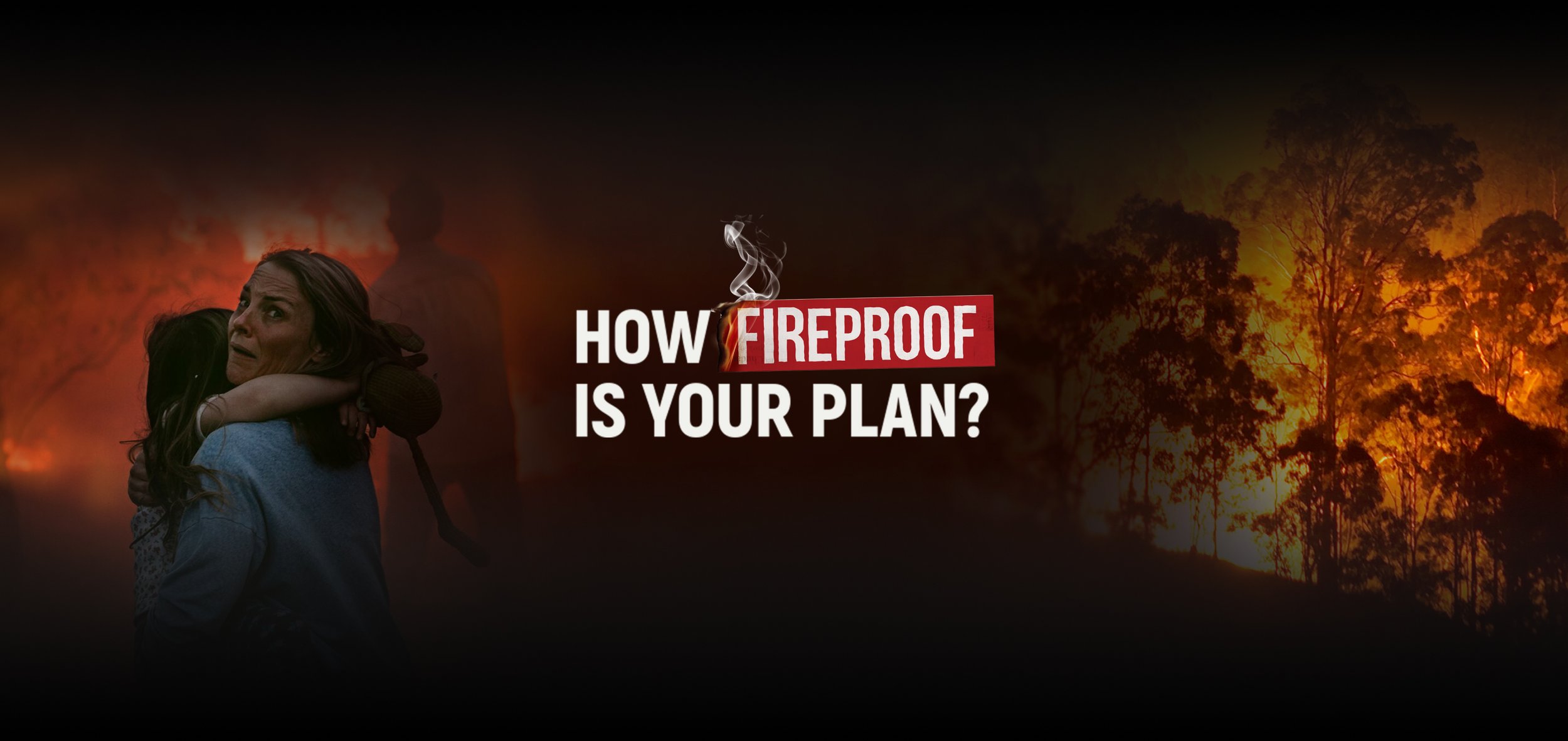
OUR WORK
My bushfire plan Empowering the WA community to be better prepared for a bushfire emergency.
Sparking a behaviour change
The Department of Fire and Emergency Services (DFES) is uniquely positioned in the emergency management sector as the primary body responsible for natural hazard preparedness. The severity of the impact of an emergency on the Western Australian community depends largely on how prepared they are for different situations. Because of this, DFES has an important role in driving behaviour change in the community to encourage people to be proactively prepared for natural hazards. A cultural shift in general public sentiment was needed for them to understand their personal risk profile for bushfires. While 90% of WA residents live in a bushfire-prone area, only 34% believe they are at risk.
After some research, it was identified that the gap in community preparedness could be distilled down to a few key factors:
Western Australians failing to perceive their own personal risk relating to bushfire and other hazards;
Not taking any action due to preparedness steps being too onerous; and
Not knowing what to do and in what situation(s).
Previously DFES had released various campaigns and communications in the lead up to peak bushfire season, alongside a Bushfire Preparedness Toolkit which included a paper-based bushfire plan. DFES had no way of tracking how many people were utilising these plans and its effect on their hazard preparedness, including how many people were taking the first step to create a plan, if they were choosing the right plans for their individual situation, if they were making updates to the plan after creation and how readily they might be sharing these plans within their households.
When DFES Digital Communications Team approached Hatchd to support in the creation of a public-facing website for the “How Fireproof is Your Plan” campaign in 2020, we identified an opportunity to spark the change from paper-based plans and seasonal campaigns, to a digital service.
A service that could be accessed year-round to educate and empower Western Australian to be more aware and prepared according to their needs - encouraging preparedness as a habit, instead of a once off task.

Forming the vision for the service
The Hatchd and the DFES team shaped the service vision and goals and a plan for a first release. This service vision was developed with a long term strategy in mind, building the core foundation in a larger service roadmap that could encompass preparation for other hazards in the future. It was identified though, that the priority hazard would be bushfires, with the first iteration being called My Bushfire Plan.
Once the user requirements were gathered and the goals were clearly defined, a prioritisation of features was conducted and it was identified that the first release of the service would contain the following functionality:
A step-by-step guide that helps users choose the type of preparation plan that suits their needs.
Questions, resources and prompts in each step to help the user think about their preparation journey carefully.
Reminders all year round to encourage revisiting existing bushfire plans and performing other preparedness activities.
Ability to share plan with other household members.
Due to the nature of the service and the scenario in which it would be used, it was also identified that a critical functionality was to allow users to access it at anytime, anywhere, even with low connectivity. Therefore, what was originally planed be a web online platform, was extended to have a companion app component, requiring the skillset of our app development sister company, Adapptor.
Hatchd then worked closely with the DFES team to dive deep into the different user journeys and to understand in detail what was required in preparing for a hazard such as a bushfire. These inputs helped us co-design and reimagine each step of the plan, whilst also considering how to inform and change user behaviour while they are completing their plan.
The user flows were developed into wireframe concepts depicting how a user might find out about My Bushfire Plan all the way up to completing a plan. These prototypes were then validated with real-world users from an array of different user types in order to get sufficient breadth and depth of feedback. Through designing the service, we were able to utilise and incorporate creative elements from previous campaigns. The service needed to be engaging and recognisable whilst also ensuring it was designed to be easy to use.
Solutioning and scaling across different platforms
The My Bushfire Plan service consisted of both a web and app component, requiring the technology stack to be robust, scalable and cost effective. The React JavaScript framework and its native incarnation, React Native, was a logical choice to facilitate consistent, scalable components across the web and app platforms. A headless CMS (Sanity) allowed DFES team to host content in one single repository shared between all platforms - a single source of truth for FAQs, disclaimers, reminders and checklists.
It was vital for plans to be accessible anytime, any place so offline functionality within the app was critical. It was a core requirement for users to be able to update their plans offline and sync once they had regained connectivity. Bushfire plans were automatically synced across the web, Android and iOS in real time with a solution developed by Hatchd and Adapptor involving a combination of Firebase Authentication and Cloud Firestore.
True preparation for bushfires requires people to complete proactive tasks throughout the year. From simple tasks like cleaning gutters and pruning shrubs, to complex activities like installing underground water pumps, they can all make the difference in averting disaster. These activities vary depending on your properties location and your plan. We developed the ability for DFES to add, update and schedule reminders based on regions across WA through a user friendly CMS. This ensures reminders are delivered, via the web and native app, at the right time to the right people.
The Outcome
For the first time ever, DFES now has the ability to track plan completion rates by region, view how these plans are being completed and how they are shared and use insights to further improve the service. The service was launched in November 2020 and can be accessed on the web at My Bushfire Plan, the App Store and the Play Store.
We have received a great response from the community, and the app currently has 850+ reviews on the App Store and 340+ reviews on the Play Store with an average score of 4.7. One particular Google review was especially heartwarming, illustrating the impact the service can have on individuals, groups and families across the state. The service has had a key role in sparking preparedness conversations across WA, and the DFES team achieved their bushfire completion KPIs within the first 6 months of the service going live.
“Hey Guys, THANK YOU so very, very much for creating this App. I am very grateful to have access to this extremely useful resource. Being a little old lady of 69 years of age, who does live alone, I really do know that WHEN YOU PANIC IS WHEN YOU FORGET how to do even the simplest of tasks... So YES, I am extremely grateful to have now filled out MY VERY OWN BUSHFIRE PLAN.. Thank you darlings for putting my mind at ease... you, my love, are bloody great mate! Thank you.”
My Bushfire Plan sets the foundation for creating a culture of preparedness within the state. It allows for Western Australians and their families to be more prepared for hazards, and uses the power of an engaged and informed community to facilitate a marked change in behaviour.
The innovation and change that DFES using My Bushfire Plan is driving was recognised by IPAA 2022 Achievement Awards, where it won the Best Practice in Innovation Award.
We are regularly reviewing user insights and feedback to continually improve and optimise the service. Stay tuned for upcoming releases coming soon, and if you live in WA, the reality is you need a bushfire plan.




